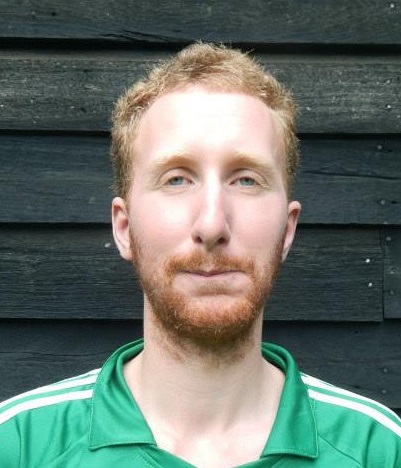FOCUS
An interview with Guillaume Dezecache, former PhD student at the DEC/IEC
Guillaume Dezecache, who defended his PhD on the propagation of emotions in 2013, has received an award from the Chancellerie des Universités de Paris for his dissertation. In this interview, he talks about his background and his work with the two DEC teams in which he carried out his research (Laboratoire de Neurosciences Cognitives and Institut Jean Nicod).

What did you do before starting a PhD at the Département d'études cognitives ?
Contrary to many PhD students for whom science has always been a true vocation, I must admit that I started my studies without knowing exactly what I would do with my life. After high school, I started a BA in Philosophy and Social Sciences at the University of Lille (I was then particularly interested in politics). In parallel, I studied for a BA in Litterature (which I did not complete as I was running out of time). At the end of my BA, I heard about topics in the philosophy of mind by Alexandre Billon, a former PhD student at IJN and lecturer at the University of Lille. It was a revelation. I contacted Dan Sperber and his former PhD students (Olivier Morin, Nicolas Baumard, Hugo Mercier) and I came to Paris to attend Kim Sterelny's lecture (he received the Jean Nicod prize that year - 2008). I then discovered the field of cognitive anthropology and started the Cogmaster program. Daniel Andler pushed me to discover the field of neurosciences by going to the interdisciplinary courses offered by the Cogmaster program. I eventually got interested in social cognition. For the second year of the master program, after having done internships with various research teams and people at IEC (Julie Grèzes's team and Dan Sperber's team as well as Elisabeth Pacherie) and got acquainted to different techniques (specifically fMRI and EEG), I asked Julie Grèzes and Dan Sperber to supervise my work on emotional transmission.
What was the topic of your PhD thesis ?
Crowd psychologists of the 19th and 20th centuries have left us with the idea that emotions are so contagious that they can cause
large groups of individuals to rapidly and spontaneously converge on an emotional level. Good illustrations of this claim include
situations of crowd panic where large movements of escape are thought to emerge through local interactions, and without any centralized
coordination. To be honest, the idea of tackling this issue did not immediately come to my mind. In June 2009, I was looking for a question
to investigate for the second year of my Master's thesis (I was then very interested by the process of emotional contagion but I had little idea of what exactly could be done). Dan Sperber mentioned an example of crowd panic after a demonstration on the 4th of September 1958. On this day, de Gaulle was presenting the new constitution at Place de la République in Paris. Crowd panic emerged among the protesters after they had been charged by the police.
I found that studying the transmission of fear was an original and fecund idea. After my master's degree, I obtained funding from DGA-MRIS to study this topic further.
The aim of my project was to investigate the propagation of two allegedly contagious emotions, i.e., fear and joy. I specifically got interested in the mechanisms that make emotional transmission possible. This is a very interdisciplinary topic: it drew from work in the domain of sociology and social psychology but was to be investigate with empirical methods.
Why did you chose to study at the DEC/IEC ?
It seemed to me that the DEC/IEC is one of the rare environments where true interdisciplinarity is possible
(i.e., a place where interdisciplinary is genuinely positively seen and where it is practically possible,
in particular given the physical proximity among the different teams within the department). I got accepted at
the PhD program of the London School of Economics but I eventually chosed to stay in Paris, for various reasons
(including the interdisciplinarity of the department). Finally, the Cogmaster is a brilliant programme in that
it creates a genuine intellectual atmosphere, which in turns favours long-term collaboration between students
(years after the end of the master program, I published two papers in collaboration with Jean-Rémy Martin, a former Cogmaster student and former PhD student at Institut Jean Nicod).
You did your PhD under the supervision of a neuroscientist - Julie Grezes from the Laboratoire de Neurosciences Cognitive team - and a philosopher - Pierre Jacob from the Institut Jean Nicod. How did you manage to work with two different teams?
Since the completion of my Phd project implied a large literature review, the intellectual proximity with Pierre Jacob was crucial to set up the project.
The ideas were then systematically discussed between Pierre Jacob, Julie Grèzes, Dan Sperber, Laurence Conty and myself before we designed the experimental protocols at the LNC.

What is your current research topic? And what are your plans for the future?
I now am a postdoctoral fellow at the University of St Andrews (with a grant from the Fyssen fondation), supervised by Klaus Zuberbühler and
Marina Davila-Ross. I work on a topic which is somewhat distant from what I was doing during my Phd: the role of emotion in the vocal
production of common chimpanzees. I spend half of the year at the forest of Budongo, in Uganda, to collect data that I analyze back in Europe.
I also still collaborate with former and current members of the DEC/IEC (such as Luc Arnal). As to the future, research is a very competitive environment but I will go on as long as I can get funding.
- Guillaume Dezecache's personal website
- Guillaume Dezecache's PhD thesis
"Studies on emotional propagation in humans: the cases of fear and joy"
- Julie Grezes'personal website
- Pierre Jacob's personal website
- Institut Jean Nicod website
- Laboratoire de Neurosciences Cognitives website
DEPARTMENT LIFE
Nomination
Etienne Koechlin, director of the Laboratoire de Neurosciences Cognitives, has been appointed member of the Science editorial board. Its appointment is effective October 1st.
Research grant
Anne-Catherine Bachoud-Levi, head of the team NeuroPsychologie Interventionnelle, has obtained a CRC 2014 E-cohorte grant.
Title: "Développement et évaluation d'une e-cohorte pour la maladie de Huntington (eCogHD)".
SOME RECENT PUBLICATIONS
Forgeot d’Arc, B., Ramus, F., Lefebvre, A., Brottier, D., Zalla, T., Moukawane, S., . . . Delorme, R. (2014). Atypical Social Judgment and Sensitivity to Perceptual Cues in Autism Spectrum Disorders. Journal of Autism and Developmental Disorders. doi: 10.1007/s10803-014-2208-5
Abstract:
Evaluation of faces is an important dimension of social relationships. A degraded sensitivity to facial perceptual cues might contribute to atypical social interactions in autism spectrum disorder (ASD). The current study investigated whether face based social judgment is atypical in ASD and if so, whether it could be related to a degraded sensitivity to facial perceptual cues. Individuals with ASD (n = 33) and IQ- and age-matched controls (n = 38) were enrolled in this study. Watching a series of photographic or synthetic faces, they had to judge them for "kindness". In synthetic stimuli, the amount of perceptual cues available could be either large or small. We observed that social judgment was atypical in the ASD group on photographic stimuli, but, contrarily to the prediction based on the degraded sensitivity hypothesis, analyses on synthetic stimuli found a similar performance and a similar effect of the amount of perceptual cues in both groups. Further studies on perceptual differences between photographs and synthetic pictures of faces might help understand atypical social judgment in ASD.
Koechlin, Etienne (2014). A evolutionary computational theory of prefrontal executive function in decision-making. Phil. Trans. Royal Soc. B, 369-20130474. (open access)
Abstract:
The prefrontal cortex subserves executive control and decision-making,
that is, the coordination and selection of thoughts and actions in the service
of adaptive behaviour. We present here a computational theory describing the evolution
of the prefrontal cortex from rodents to humans as gradually adding new inferential
Bayesian capabilities for dealing with a computationally intractable decision problem:
exploring and learning new behavioural strategies versus exploiting and adjusting previously
learned ones through reinforcement learning (RL). We provide a principled account identifying
three inferential steps optimizing this arbitration through the emergence of (i) factual
reactive inferences in paralimbic prefrontal regions in rodents; (ii) factual proactive
inferences in lateral prefrontal regions in primates and (iii) counterfactual reactive and
proactive inferences in human frontopolar regions. The theory clarifies the integration of
model-free and model-based RL through the notion of strategy creation. The theory also shows
that counterfactual inferences in humans yield to the notion of hypothesis testing, a critical
reasoning ability for approximating optimal adaptive processes and presumably endowing humans
with a qualitative evolutionary advantage in adaptive behaviour.
Reyes, G & Sackur, J. (2014) Introspection during visual search, Consciousness and Cognition, 29, 212-229
Abstract:
Recent advances in the field of metacognition have shown that human participants are introspectively aware of many different cognitive states, such as confidence in a decision.
Here we set out to expand the range of experimental introspection by asking whether participants could access,
through pure mental monitoring, the nature of the cognitive processes that underlie two visual search tasks: an effortless “pop-out”
search, and a difficult, effortful, conjunction search. To this aim, in addition to traditional first order performance measures,
we instructed participants to give, on a trial-by-trial basis, an estimate of the number of items scanned before a decision was reached.
By controlling response times and eye movements, we assessed the contribution of self-observation of behavior in these subjective
estimates. Results showed that introspection is a flexible mechanism and that pure mental monitoring of cognitive processes is
possible in elementary tasks.
CALENDAR

November 5, 7, 2014
Context and Content Lectures - Imogen Dickie (University of Toronto - Professeure invitée à l'ENS, Dpt d'études cognitives)
Read more...

November 6, 2014
HDR Defense - Laurence Conty (LNC): "Le pouvoir réfléxif du contact par le regard"
Read more...

November 6, 2014
One day workshop - "Perception"
Read more...

November 12, 14, 18, 20, 2014
Awards and Conferences Jean Nicod 2014 - Chris and Uta Frith
Read more...

November 14, 2014
IJN Colloquium - Olav Gjelsvik (University of Oslo): "Practical Knowledge and Self-Knowledge"
Read more...

November 18, 2014
Compas / IJN seminar - Education & Cognition: Valeria Giardino (IJN): Body and algebra. From theater to school.
Read more...

November 26, 2014
IJN Colloquium - John Bengson (University of Wisconsin–Madison): "The Unity of Understanding"
Read more...
DEC/IEC calendar on the DEC/IEC website.
DEC/IEC colloquium program, archives and audio recordings on the DEC/IEC website.
Subscribe to the newsletter
Unsubscribe from the newsletter
